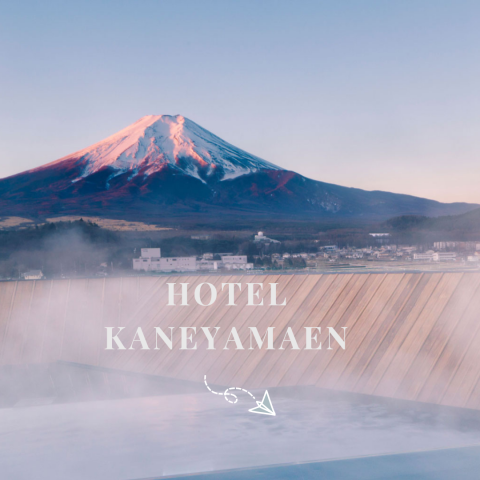Main content starts here.
Mt. Fuji Area’s Itinerary, bearing the subtitle “Exploring Mt. Fuji’s Traditional and Innovative Landscape,” drew me in not just for Mt. Fuji and Fujiyoshida City, but also the first location on the tour. Aokigahara Forest, which some readers will no doubt recognize for its infamous reputation. In fact, it is an astonishing destination in its own right.
Aokigahara Forest
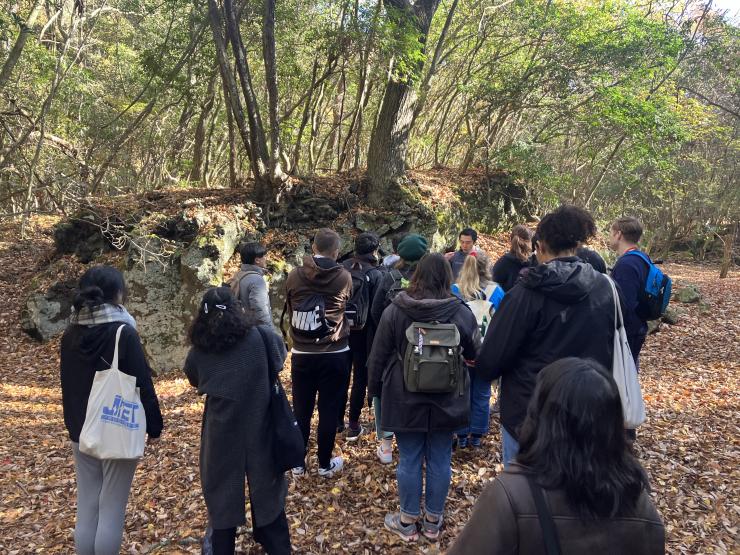
▲Mr. Chishiro guiding us through Aokigahara Forest.
Naturally, much of our 70 or so minutes in Aokigahara was given to considering and dispelling the notion of the forest itself as a bad omen. I think myself lucky that our guide, Mr. Chishiro Satoshi, was such a charismatic and passionate ambassador for the area. Chishiro, whose business “thousandth” offers tours of the Mt. Fuji area, brought both unmistakable enthusiasm and the kind of personal relationship to the land that any modern traveler hopes to experience. Besides enjoying Chishiro’s relaxed manner throughout the day (he guided us at Aokigahara and at Fuji Sengen Shrine), we came to understand that thousandth formed part of a living ecosystem; one made up of young local entrepreneurs - some born and raised, others recently arrived - who each contribute to local economic revitalization through their work in tourism.
On the subject of living ecosystems - Aokigahara. A friend of mine warned me before I left that she would not welcome me home before I was cleansed of evil (such is the reputation). What I noticed immediately on that beautiful autumnal morning was the sense of quietude at Aokigahara - indeed, the lava rock which makes up the soil bed of the forest has the effect of absorbing sound. If there are souls to be met at Aokigahara, I imagined they must be quite peaceful. Chishiro explained to us that the lava, deposited hundreds of years ago during an eruption at Mt. Fuji, had laid a foundation in which huge amounts of plant and animal life had come to thrive. Ours was a relatively short trek through the shallow edges of the forest, and yet we were given copious examples of the trees that absorb their nutrients not by burrowing deep underground, but by clinging to the moss that grows over the soil. The silent forest was not a place of death, but a case study in the dogged persistence of life.
Chishiro, who heard from most of us at the start of the tour about our negative associations with Aokigahara understood the significance of stories. His tour was more than facts and figures, instead conveying with that deep local knowledge the history and the personality of the forest. In a country such as Japan - where beauty and history are everywhere - what draws the modern traveler is the story. A visit to Aokigahara is not just a story that shifts the narrative on the destination itself, but one that a visitor will carry with them long after they may leave. By the time we exited back to the quiet yellow-grassed surroundings, I no longer felt like I would need to be cleansed before I returned home.
Fujisan World Heritage Center
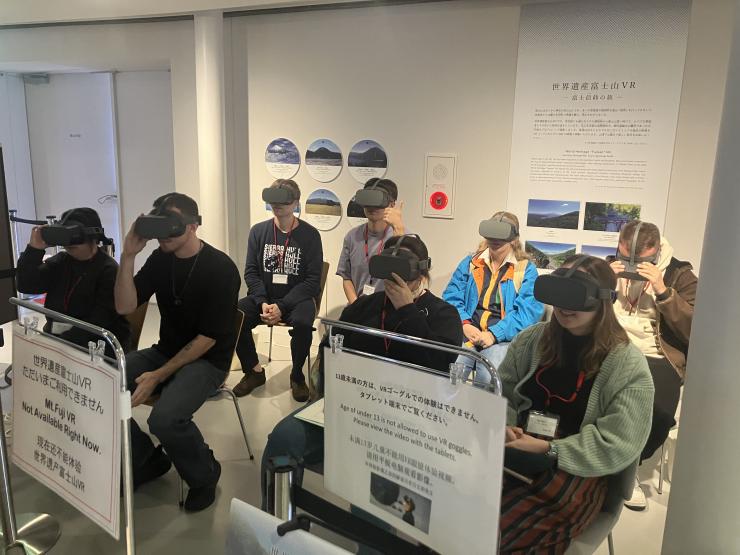
▲Trying out the VR headsets at Fujisan World Heritage Center.
While we did not climb Mt. Fuji as part of our course, we did make a stop after Aokigahara at the Fujisan World Heritage Center. As the name suggests, this visitor center was opened as a hub of information on Mt. Fuji shortly after the mountain’s inscription as a UNESCO World Heritage Site. For fans, such as myself, of the well-preserved relationship between modern Japan and the materials of the past, the center was something of a playground. We were guided through the regalia of mountaineers in the past, the religious significance of the mountain through the centuries since its first ascent, and its continued cultural status today.
While the word “playground” might seem flippant when describing Japan’s most internationally famous symbol, it is hard not to feel a kind of childlike giddiness in the area. Having never visited Mt. Fuji previously, I was stunned by the experience of standing outside the center in the massive presence of the mountain. There were a great many resources to learn about and experience Mt. Fuji in the center (including some stunning virtual reality items), but the overpowering sense of the mountain itself remains undiminished.
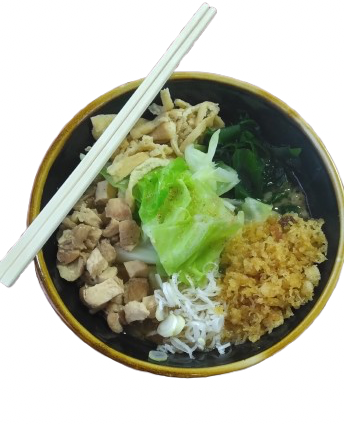
▲Yoshida Udon
Part of the joy any traveler to Japan will recognize is to indulge in 'meibutsu' - the extraordinarily well-developed culture of regional cuisine. Our lunch for the day was Yoshida Udon, noted for the chewy texture of the noodles as well as the soft-spicy miso-soy broth. It needs not be said that there was something extra special to have my first taste of Yoshida Udon within striking distance of Mt. Fuji. Despite the valid concerns that exist around preserving the mountain and its surroundings in the face of overtourism, the chance still exists to experience the authenticity of the locale - not to mention getting closer to the culture - through 'meibutsu'.
Good Old Market
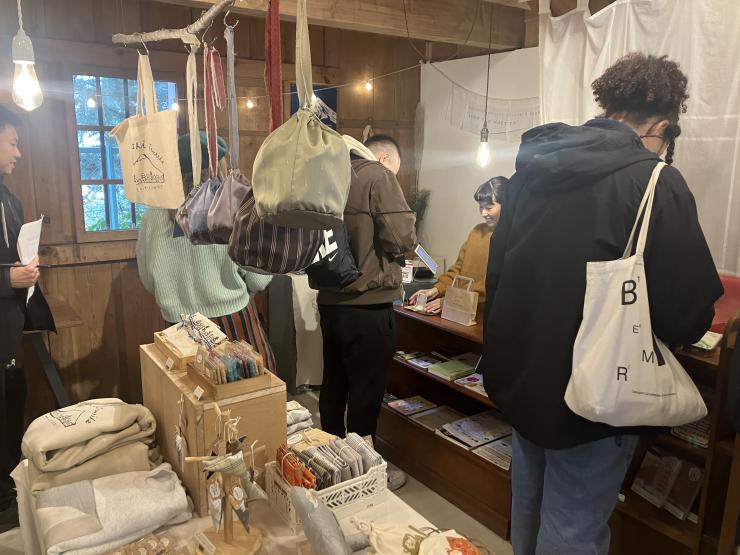
▲Visiting Ms. Kataoka’s shop, Good Old Market.
The afternoon portion of the course took us on a journey through Fujiyoshida City’s Honcho Street. You will certainly recognize this place by sight if not by name. Some of the most iconic imagery of Mt. Fuji is of the mountain seen from Honcho Street. Imagery is nice, but what’s nicer is substance; besides snapping some pictures, we visited the textile souvenirs shop Good Old Market. Ms. Kataoka Mio opened this store after she finished a graduate degree in textile design in Tokyo. Not unlike Mr. Chishiro, Ms. Kataoka’s work struck me as expanding the horizons of tourism - broadening the scope of a visitor’s engagement with a locale and deepening the cultural exchange that we want out of our travels.
This sense of scope was increased as we made our way around the nearby Shinsekai Kampai Street. Formerly a 'yokocho'-style hub of bars and clubs, the alleys have been revived in recent years with a modern take on Japanese nightlife. I believe that this was the most intriguing location of all. The revival of social nightlife by way of repurposing nostalgic sidestreets is something that I have seen happen in my own corner of Japan, and I felt both a sense of local pride and tourist excitement to realize the same thing is happening throughout Japan. It would be a sad end indeed if Fujiyoshida City were to become nothing more than a collection of buildings near Mt. Fuji, and it is the rebuilding of a living city culture that guarantees the authenticity of experience for modern travelers.
Hikari Orimono Factory
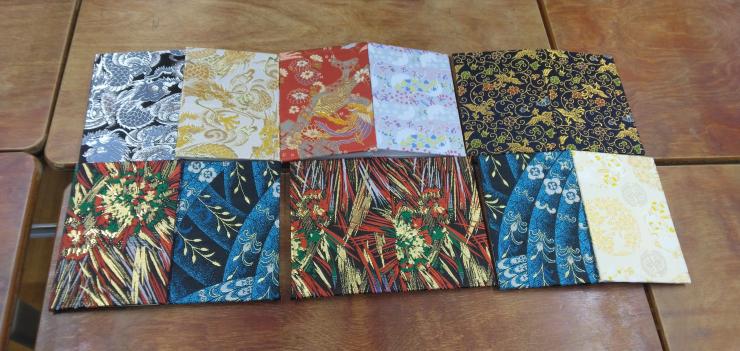
▲Our very own handmade ‘goshuincho’.
Another similarity of Fujiyoshida to my own home in Japan is the prevalence of a long textile history. We visited Hikari Orimono factory to learn about this history, which is carried on as an active industry rather than as a museum. Most striking of all - we had the opportunity to select textile covers and put together our very own 'goshuincho' - the journal-esque stamp books in which visitors to temples or shrines can receive hand-drawn (or printed) seals commemorating the visit. I have long believed that 'goshuincho' would help the unfamiliar visitor make the leap from simply visiting a destination to truly experiencing it, so it was both fun and touching to make a 'goshuincho' of my own and go from simply having visited Hikari Orimono to having truly experienced it.
Kitaguchi Hongu Fuji Sengen Shrine
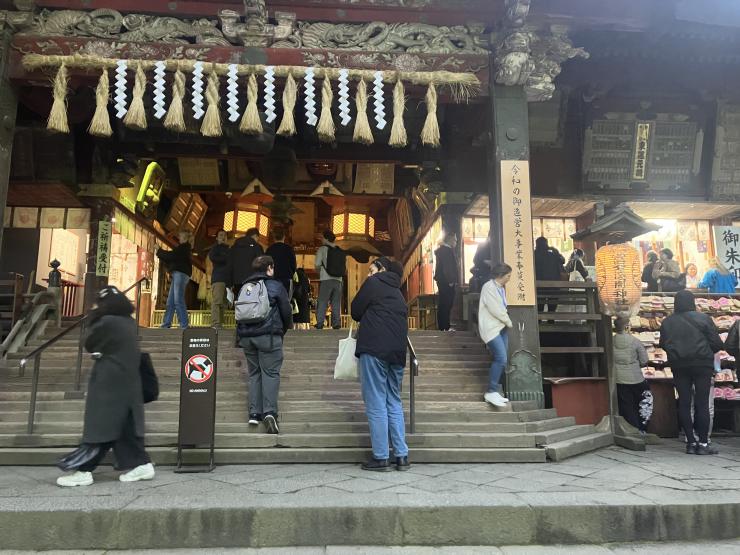
▲Getting our ‘goshuin’ stamp at Kitaguchi Hongu Fuji Sengen Shrine.
The day for us ended at the beginning - Fuji Sengen Shrine is perhaps the most famous gateway to Mt. Fuji for climbers. We met with Mr. Chishiro again, who explained to us the story of the shrine and the manner expected. As with Aokigahara, I was struck by the significance of knowing the details. He illuminated for us the gestures that to non-native visitor may seem arbitrary, and loosened the grip of fear that comes in such situations. Leaving Fuji Sengen Shrine and the course with my first-ever 'goshuin' stamp, I felt that the evidence stood to prove that the fear that comes with going beyond the surface in Japan had been very much cleansed.
More Info
Fujisan World Heritage Center(山梨県立富士山世界遺産センター)
Address: 6663-1 Funatsu, Fujikawaguchiko, Minamitsuru District, Yamanashi 401-0301
Hours: 9 AM – 5 PM
Website (EN) : https://www.fujisan-whc.jp/en/index.html
Mr. Chishiro’s website (JP): https://thousandth1000th.net/
Good Old Market
Address: 〒403-0009 Yamanashi, Fujiyoshida, Fujimi, 1-chome−1−5 3F
Website (JP) : https://goodoldmarket.stores.jp/
Hikari Orimono Factory(光織物有限会社)
Address: 9-chōme-35-7 Shimoyoshida, Fujiyoshida, Yamanashi 403-0004
English Info: https://fujiyoshida.net/en/see-and-do/176
Kitaguchi Hongu Fuji Sengen Shrine(北口本宮冨士浅間神社)
Address: 403 Kamiyoshida, Fujiyoshida, Yamanashi 403-0005
English Info: https://www.yamanashi-kankou.jp/english/uncover/kitaguchi-hongu-fuji-sengen-shrine.html
Published on
- February 7, 2024
Share
-
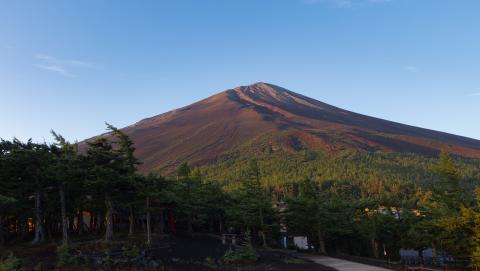
Fuji Subaru Line 5th Station & Mt. Fuji Travel Guide
March 3, 2025
ホーム > A Different View of Fuji
